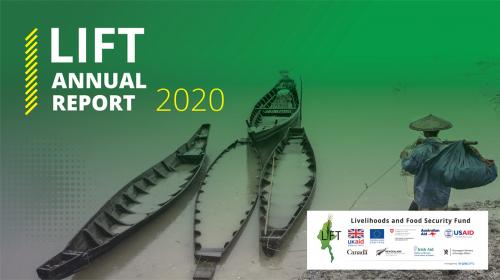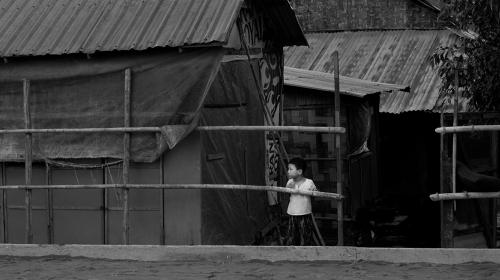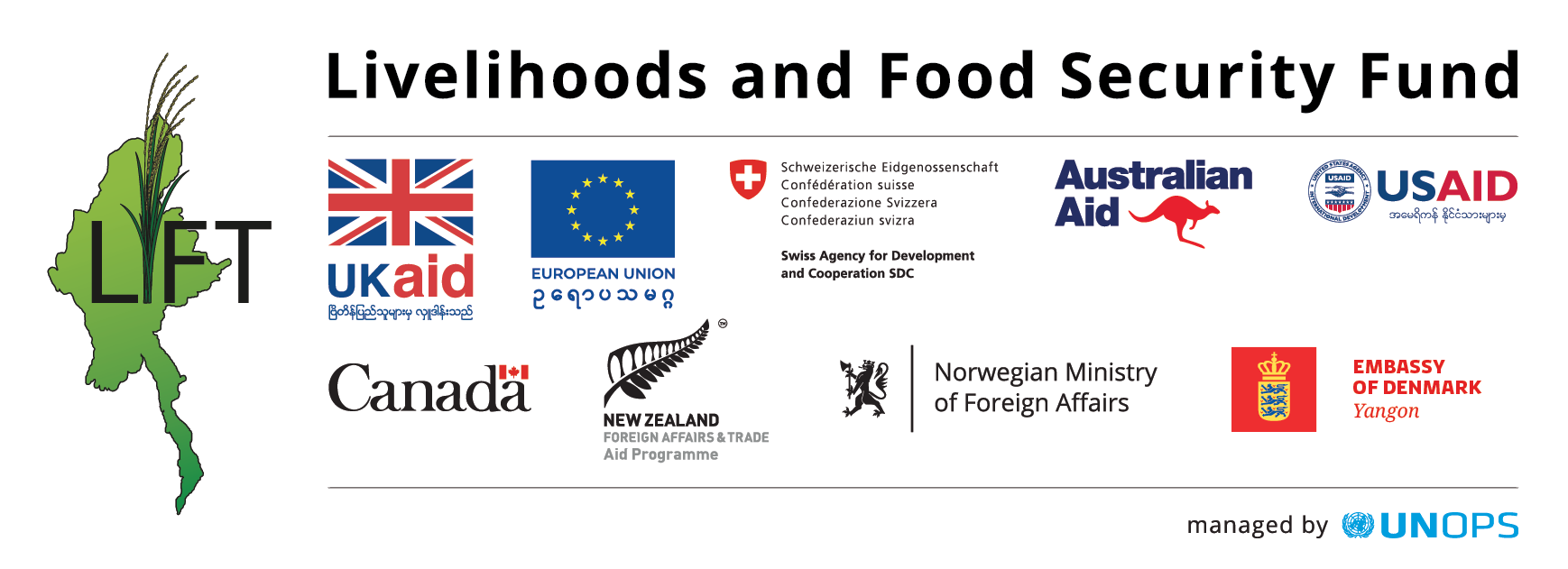
Disruptions to the agri-food system have been persistent and are becoming more severe. Farmers are investing less in inputs for the 2021 monsoon season due to the higher cost (especially fertilizer) and the uncertainty concerning output markets. At the same time, many smallholder farmers are cash constrained while credit markets for farm input purchases are in disarray due to the mixed signals to farmers about their repayment obligations and the broader ongoing financial system crisis.
The effects are already being felt in lower farmgate prices and higher consumer prices for food, which may pose risks as the main agricultural season, the monsoon season, is underway.
Smallholder farmers typically borrow funds at the start of their planting seasons for rice, beans and pulses, and increasingly maize/corn, and repay lenders when crops are sold, generally 5-6 months later. 2021 however has broken the established business cycle.
"Fertilizer costs have increased almost twofold during this rainy season and my income from the boat transportation, which I used to reinvest in the rainfed paddy season in May and June have shrunken to 30% of what it was before. We are now forced to consume our income and not invest it.”
Without the working capital loans that farmers have come to depend on, farmers economize on fertilizers and other valuable agricultural inputs, lowering their crop yields and incomes. Without extra funds, farmers hire fewer day laborers, creating further distress for landless workers and rural economies.
The challenge is even more acute as all input prices have risen significantly, led by fuel and fertilizers’ prices rocketing due to global oil price increases and a 30-35 percent devaluation of the kyat against the US dollar since the start of 2021.
A 46-year-old single mother of five and a farmer from Mandalay Region, falls behind this sorrow statistics. A member of the microfinance scheme for the last three years, she has been using loans to grow paddy, beans, sesame and betel leaves. The outbreak of the COVID-19 third wave, drought and the unfolding political crisis have affected her production and left her without affordable lending at a time when she needs it most.
"Insecurity and travel restrictions affected my income from selling betel leaves, which we used for family needs. Recent drought and the ever growing costs for fertilizers and other inputs affected my rainfed sesame fields and I’m worried my income will be much lower this year and I will need to borrow more for the next season.” “Farmers here realize the benefits of borrowing at a relatively cheaper cost of finance from MFIs. They do not want to take informal loans nor make pre-sell arrangements of their crops to brokers whenever possible,” said a farmer and client of MFI in Ye U, located in Sagaing’s rice belt.
While a loan from a microfinance institution normally costs farmers 2.3% per month, informal borrowing typically charges 5% per month, while farmers can pay up to 8-10% of the value of their harvest to brokers who lend them money to help fund planting. Recently, farmers are required to pay for their inputs with cash rather than on credit terms, further straining their resources.
“People in the community try their best not to miss any principal and interest payments as they want MFIs to continue operating in the village,” says the farmer, echoing widespread concerns that the government-operated Myanmar Agricultural Development has halted its credit operations.
As farmers strive for affordable loans, microfinance institutions halt their services over severe operational and funding difficulties
Myanmar’s most reliable rural lenders, microfinance institutions (MFIs), are facing severe disruptions to their businesses – with field staff prevented from coming to work, customers missing scheduled repayments, and troubled local banks trapping MFIs’ funds that otherwise would be repaid to lenders or distributed as local loans or staff salaries.
While both the rural economy and MFIs claw through day-to-day operating challenges, a larger crisis looms if Myanmar’s MFIs go out of business or run out of funds to lend to their estimated 4 million borrowers[2] due to the meltdown of the domestic banking sector and as foreign lenders’ pause on new loans for Myanmar’s financial sector.
Like the rest of the country, MFIs struggle to transact through local banks or get their hands on enough cash - kyat or US dollars - to conduct business normally or repay their offshore loans. Late payments and the drumbeat of bad news from Myanmar has put foreign lenders on high alert.
Unless renewed sources of funding quickly emerge and/or existing obligations are rescheduled, MFIs will be forced to further curtail their lending and unable to assist their vulnerable rural clients who will continue to suffer lower incomes and harder times.
Some MFIs have already started rationing credit, reducing the size of loans to their customers.
“We are coping with serious operational issues, including very limited access to our cash, non-repayment of loans, and new security issues, but what really keeps us awake at night is worrying about how we can refinance our current loans from local banks and international financial institutions as they come due over the next few years,” says the head of funding for one MFI supported by LIFT.
“We certainly don’t want to pull back. But without funding certainty, we’ll have to plan to shrink our loan book and make fewer and smaller loans just when they are needed more than ever by our clients,” the MFI executive explains, highlighting a potential sector-wide retreat in one of Myanmar’s brightest, highest impact sectors.
If MFIs cannot make new loans to customers after they re-pay, non-performing loans are liable to sky-rocket, further jeopardizing MFIs’ financial stability and their capacities to offer affordable funding to agricultural producers.
While most farmers managed to access production inputs for the monsoon season, though of lower quantity and quality, the harvest and post-harvest management of monsoon crops as well as the post-monsoon production season are under threat if no affordable loans are made available.
“As responsible lenders, we have to balance our clients’ needs against those of the institution,” says a manager of a LIFT-funded MFI, which operates in Sagaing and Chin State and heavily supports small-scale farmers and livestock breeders. “But without funding certainty, we can’t be there for them.”
“The very first step has been to slow our expansion,” explains the MFI manager, “The second is to reduce the size of each loan, and the third is to stop renewing clients, which greatly increases our risks because our clients, especially in these times, are understandably reluctant to repay without faith we will lend to them again - right away”.
LIFT facilitated the development of the microfinance sector to strengthen food systems…
LIFT has been strongly supporting microfinance development in Myanmar, especially in the rural areas , seeing access to finance and fair lending practices as fundamental building blocks for improving rural livelihoods and resilience among households and small businesses.
Since its start in 2012/13, LIFT-supported MFIs have reached nearly half of total individual loans in the country (2.5 million against a total 5.4 million loans), worth 1.4 billion kyats in total (against a nation-wide total of 2.6 billion kyats).
LIFT’s catalytic collaboration with the TCX programme worked to “hedge” the investor’s currency risk for the USD-to-kyat lending kyat to customers. Two rounds of funding in 2017 and 2020 effectively opened up Myanmar's MFI market to global sources of capital and directly supported more than $200 million of loans from foreign funders to Myanmar MFIs.
The vast majority of these loans were made to the rural sector to support the planting seasons, boost innovations and promote mechanisation in agriculture, leading to improved food security. Through direct grants, technical assistance for lenders and regulators alike and the sponsorship of innovative financing schemes, LIFT has helped increase the flow of more reasonably-priced credit to farmers which, in turn, has lowered the cost of essential working capital and led to investments in better seeds, fertilizers and planting techniques that can bring better returns on their seasonal toil.
As responsible MFI lending has steadily replaced higher-priced informal loans, and lessened farmers’ dependence on their suppliers or crop buyers for credit, the overall sector has grown dramatically, reaching otherwise excluded borrowers especially rural women, driving greater financial inclusion, and helping improve rural incomes. While not all MFI lending occurs in rural areas, rural borrowers have become highly reliant on MFI loans to keep planting and harvesting and bolstering their incomes through unpredictable times.
… and remains committed to support financial inclusion to revive agriculture production and boost food security
There is an imminent threat of a reversal in rural lending and direct negative consequences for rural livelihoods and smallholder farmers.
Creating “breathing space” for MFIs to reschedule some of their repayments to lenders is critical, so that lenders and borrowers can cope with new and extraordinary circumstances. This would allow MFIs to restructure outstanding loans and to extend more loans to their clients, particularly smallholder farm farmers, to sustain their livelihoods.
Only through ensuring that borrowers can continue to access essential funds will Myanmar’s MFI sector sustain its remarkable momentum and continue to play a fundamental role in supporting inclusive economic development across the country.
[1] The economy is expected to contract around 18 percent in Myanmar's 2021 Fiscal Year (Oct. 2020 – Sept. 2021), with damaging implications for lives, livelihoods, poverty and future growth, according to the World Bank's Myanmar Economic Monitor, released on July 23, 2021
[2] Based on an estimated average 1.4 microfinance loans per borrower. Source: Thitsar Works
******************
ယိုင်နဲ့လာသောအခြေအနေများ - ဘဏ္ဍာရေးအကျပ်အတည်းကြား စိုက်ပျိုးရေးကဏ္ဍ ကျဆင်း လာသည်နှင့်အမျှ မြန်မာတောင်သူများ၏ ကြံ့ကြံ့ခံရင်ဆိုင်ကျော်လွှားနိုင်စွမ်း အစမ်းသပ်ခံနေရ
ကိုဗစ်-၁၉ နှင့် စစ်အာဏာသိမ်းမှု ဟူသည့် အကျပ်အတည်းနှစ်ခု ကျရောက်လာပြီးနောက်တွင် မြန်မာနိုင်ငံ၏ ဘဏ္ဍာရေးစနစ်သည် ရပ်တန့်လုနီးနီး ဖြစ်နေပြီး နိုင်ငံ၏ စိုက်ပျိုးရေးကဏ္ဍ ဆက် လက်လည်ပတ်နိုင်ရေးအပေါ် ကြီးစွာ ထိခိုက်စေလျက် ရှိပါသည်။ နိုင်ငံ၏ စိုက်ပျိုးရေး ထုတ်ကုန် အများစုအား စိုက်ပျိုးထုတ်လုပ်ပေးနေသည့် လုပ်ကွက်ငယ်တောင်သူအများအပြားအဖို့ အကျပ်အ တည်းရင်ဆိုင်ကျော်လွှားသည့် နည်းလမ်းများမှာလည်း များစွာ အားနည်းချိနဲ့လာနေပြီး ကျေးလက် ဒေသ အသက်မွေးဝမ်းကျောင်းမှုလုပ်ငန်းများအတွက် ကြီးမားသော ခြိမ်းခြောက်မှုတစ်ခုအဖြစ် မြင်တွေ့လာရပါသည်။ [1].
ကြံ့ကြံ့ခံနိုင်စွမ်းနှင့် စားနပ်ရိက္ခာဖူလုံရေးအတွက် အထူးပင် အရေးပါလှသည့် ကျေးလက်စီးပွား ရေးကဏ္ဍတွင် တောင်သူမိသားစုများသည် ဝင်ငွေလျော့နည်းခြင်း၊ ကုန်ကျစရိတ် ပိုများလာခြင်း၊ ဈေးကွက်များထံရောက်ရှိရန် နှောင့်နှေးမှုများ ရှိခြင်း၊ ယမန်နှစ်ပိုင်းတွင် ကောက်ပဲသီးနှံ များအတွက် ငွေပေးချေမှုများအား အချိန်ကြာမြင့်စွာ စောင့်ဆိုင်းရခြင်းတို့ကြောင့် ဘက်ပေါင်းစုံမှ အကျပ်အတည်းများ ကြုံတွေ့နေရပါသည်။ မြေယာမဲ့လုပ်သားများမှာလည်း အလုပ်အကိုင်များ ပိုမို ရှားပါးလာမှုနှင့် အပြိုင်အဆိုင် ပိုမို များပြားလာမှုတို့ကို ရင်ဆိုင်နေကြရပြီး အသေးစား ကျေးလက် စီးပွားရေးလုပ်ငန်းများမှာမူ ၎င်းတို့၏ ဖောက်သည်များနှင့် ပစ္စည်းပေးသွင်းသူများ၏ လိုအပ်ချက်များကို ဖြည့်ဆည်းပေးနိုင်ရန် ရုန်းကန်နေကြရပါသည်။
စိုက်ပျိုးရေးအခြေခံ စားနပ်ရိက္ခာစနစ် လည်ပတ်နိုင်မှု မရှိသည်မှာ အချိန်ကာလ ကြာမြင့်နေပြီ ဖြစ်ပြီး ယခုအခါ အခြေအနေမှာ ပို၍ပင် ဆိုးရွားလာပါသည်။ ဈေးနှုန်းများ မြင့်တက်လာမှု (အထူး သဖြင့် မြေဩဇာဈေးနှုန်း) နှင့် ၎င်းတို့၏ ထုတ်ကုန်များအတွက် ဈေးကွက်အခြေအနေ မရေရာမှုတို့ ကြောင့် တောင်သူများသည် ၂၀၂၁ ခုနှစ် မုတ်သုန်ရာသီအတွက် သွင်းအားစုများ ဝယ်ယူရင်းနှီး မြှုပ်နှံခြင်းကို လျှော့ချလျက်ရှိနေကြပါသည်။ တစ်ချိန်တည်းတွင် တောင်သူများ ချေးငွေ ပြန်လည် ပေးဆပ်ရန် ကိစ္စနှင့်စပ်လျဉ်း၍ ရှုပ်ထွေးမှုများ ရှိနေခြင်းကြောင့်လည်းကောင်း၊ ပိုမိုကျယ်ပြန့်သည့် ဘဏ္ဍာရေးစနစ်တစ်ခုလုံး ရင်ဆိုင်နေရသော အကျပ်အတည်းကြောင့်လည်းကောင်း စိုက်ပျိုးရေး သွင်းအားစုများ ဝယ်ယူရန်အတွက် ချေးငွေဈေးကွက်မှာလည်း ဖရိုဖရဲဖြစ်လျက်ရှိရာ လုပ်ကွက်ငယ် တောင်သူများမှာ ငွေသား ရှားပါးပြတ်လပ်မှု အခက်အခဲနှင့်လည်း ရင်ဆိုင်နေကြရပါသည်။
ဤအခြေအနေများကြောင့် ဖြစ်ပေါ်လာသည့် အကျိုးရလဒ်များကိုလည်း စတင်ခံစားနေရပြီ ဖြစ်ပါ သည်။ တောင်သူများသည် ၎င်းတို့၏ ထုတ်ကုန်များအတွက် ဈေးမရသော်လည်း စားသုံးသူများ အတွက်မူ စားသောက်ကုန်ဈေးနှုန်းများမှာ မြင့်တက်လာပါသည်။ အဓိကစိုက်ပျိုးရာသီဖြစ်သည့် မုတ်သုန်ရာသီ ရောက်ရှိနေပြီဖြစ်သဖြင့် ဤအခြေအနေသည် စိုးရိမ်ဖွယ်ရာ ဖြစ်ပါသည်။
ကျေးလက်စိုက်ပျိုးရေးကဏ္ဍအတွင်းရှိ လုပ်ငန်းလည်ပတ်ချေးငွေ လိုအပ်ချက်များ ပြည့်မီရေးသည် နိုင်ငံရေးအကျပ်အတည်းကြောင့် ဝေဝါးလျက်ရှိ
ပုံမှန်အားဖြင့် လုပ်ကွက်ငယ်တောင်သူများသည် ဆန်စပါး၊ ပဲအမျိုးမျိုးနှင့် ပြောင်း အတွက် စိုက်ပျိုးရာသီအစတွင် ချေးငွေရယူလေ့ရှိကြပြီး သီးနှံများ ရောင်းချပြီးချိန် ယေဘုယျအား ဖြင့် ၅လ မှ၆လ အကြာတွင် ချေးငွေများကို ပြန်ဆပ်ကြပါသည်။ သို့သော် ၂၀၂၁ ခုနှစ်တွင် အခြေတကျ လည်ပတ်နေသော အဆိုပါစီးပွားရေးလုပ်ငန်းစက်ဝန်းသည် ပျက်ပြားသွားခဲ့ပါသည်။
ဧရာဝတီတိုင်းဒေသကြီးမှ ကလေးခုနစ်ယောက်မိခင် အသက် ၄၈ နှစ်အရွယ် တောင်သူတစ်ဦးအဖို့ အသေးစားချေးငွေများသည် အသက်သွေးကြောဖြစ်သလို သူမ၏ ဘဝကို ပြောင်းလဲစေခဲ့သည့် အရာများ ဖြစ်သည်။ သူမသည် ရရှိသည့် ချေးငွေများကို စည်းစနစ်တကျ သုံးစွဲကာ ပြန်လည်ပေးဆပ်သူတစ်ဦး ဖြစ်သည်နှင့်အညီ ချေးငွေသုံးမျိုးကို အောင်မြင်စွာ စီမံခန့်ခွဲသုံးစွဲ၍ စိုက်ပျိုး ထုတ်လုပ်မှုများကို တစ်နှစ်ပတ်လုံး လုပ်ဆောင်နိုင်ခဲ့သလို ကုန်စုံဆိုင်ဖွင့်ခြင်းနှင့် မော်တော်ဘုတ် အငှားလိုက်သည့် ဝန်ဆောင်မှုကဲ့သို့သော စီးပွားရေးလုပ်ငန်းများကိုလည်း လုပ်ကိုင်နိုင်ခဲ့ပါသည်။ ထိုလုပ်ငန်းများကလည်း အလုပ်သမား ဆယ်ယောက်အတွက် အလုပ်အကိုင် ဖန်တီးပေးနိုင်ခဲ့ပါသည်။ သို့သော် ကိုဗစ်-၁၉ နှင့် စစ်အာဏာသိမ်းမှု နှစ်ခုပေါင်း၍ ဖြစ်ပေါ်လာသည့် အကျိုးသက်ရောက်မှုများကြောင့် ဒေါ်ဌေးဌေးဝင်း၏ စီးပွားရေးလုပ်ငန်းများအတွက် ထင်မှတ်မထားသည့် အခက်အခဲများ ကျရောက်လာခဲ့ပါသည်။
"ဒီနှစ် မိုးတွင်းမှာ မြေဩဇာဈေးနှုန်းတွေက နှစ်ဆလောက်တက်လာပါတယ်။ လှေငှါးတာကနေရတဲ့ ဝင်ငွေကို မေလနဲ့ ဇွန်လတွေမှာ မိုးစပါးအတွက် ပြန်ပြီး ရင်းနှီးမြှုပ်နှံဖို့ သုံးပါတယ်။ အဲဒီဝင်ငွေကလည်း အရင်ကထက် ၃၀ ရာခိုင်နှုန်းလောက် လျော့သွားပါတယ်။ အခု ကျွန်မ တို့မှက ရတဲ့ဝင်ငွေလေးက စားဖို့သောက်ဖို့လောက်သာရတာမို့ ရင်းနှီးမြှုပ်နှံတာတွေ မလုပ်နိုင်တော့ဘူး” ဟု သူမက ဆိုပါသည်။
တောင်သူများ မှီခိုအားထားရသည့် လုပ်ငန်းလည်ပတ်ချေးငွေများ မရရှိသောအခါ တောင်သူများ သည် မြေဩဇာနှင့် အခြား အရေးကြီးသည့် စိုက်ပျိုးရေးသွင်းအားစုများကို ချွေတာလိုက်ရသဖြင့် သီးနှံအထွက်နှုန်းနှင့် ဝင်ငွေများကို လျော့ကျသွားစေပါသည်။ ငွေပိုမရှိသဖြင့် ငှားရမ်းထားသည့် နေ့စားအလုပ်သမား အရေအတွက်ကိုလည်း လျှော့ချလိုက်ပြန်ရာ မြေယာမဲ့ လုပ်သားများနှင့် ကျေးလက်စီးပွားရေးကဏ္ဍတို့အတွက် အကျပ်အတည်းများပါ ပို၍ပင်ကြီးမားလာပါသည်။
ထို့အပြင် ကမ္ဘာ့လောင်စာဆီဈေးနှုန်းများ မြင့်တက်နေမှုနှင့် ၂၀၂၁ ခုနှစ် အစောပိုင်းမှစ၍ အမေရိ ကန်ဒေါ်လာနှင့် လဲလှယ်သည့် မြန်မာကျပ်ငွေတန်ဖိုးသည် ၃၀-၃၅ ရာခိုင်နှုန်း ကျဆင်းခဲ့မှုကြောင့် သွင်းအားစုအားလုံးမှာ ဈေးနှုန်းများ သိသိသာသာ မြင့်တက်လာရာ စိန်ခေါ်မှုများမှာ ပို၍ပင် ကြီးမားလာပါသည်။
မန္တလေးတိုင်းဒေသကြီးမှ ကလေးငါးယောက်အား တစ်ဦးတည်း ကျွေးမွေးစောင့်ရှောက်နေရသည့် အသက် ၄၆ နှစ်အရွယ် မိခင်ဖြစ်သူ တောင်သူတစ်ဦးမှာလည်း အထက်ဖော်ပြပါ အခက်အခဲများကို ရင်ဆိုင်နေရပါသည်။ သူမသည် လွန်ခဲ့သည့် သုံးနှစ်တာကာလအတွင်း အသေးစားချေးငွေအစီအစဉ် အဖွဲ့ဝင်တစ်ဦး ဖြစ်ခဲ့ပြီး ရရှိသော ချေးငွေများအား အသုံးပြု၍ စပါး၊ ပဲ၊ နှမ်းနှင့် ကွမ်းရွက် တို့ကို စိုက်ပျိုးခဲ့သည်။ ကိုဗစ်-၁၉ တတိယလှိုင်းရိုက်ခတ်မှု၊ မိုးခေါင်ရေရှားမှုနှင့် ဖြစ်ပေါ်လာသော နိုင်ငံရေးအကျပ်အတည်းများက သူမ၏ စိုက်ပျိုးထုတ်လုပ်မှုများကို ထိခိုက်စေခဲ့ပြီး သူမအတွက် ချေးငွေအလိုအပ်ဆုံး ဖြစ်နေချိန်တွင် သူမ တတ်နိုင်သော အတိုးနှုန်းဖြင့် ချေးငွေ ရယူနိုင်ခြင်း မရှိပဲ ဖြစ်နေပါသည်။
"လုံခြုံရေးအခြေအနေနဲ့ ခရီးသွားလာခွင့် ကန့်သတ်ချက်တွေကြောင့် ကွမ်းရွက်ရောင်းရတဲ့ ဝင်ငွေကို ထိခိုက်လာပါတယ်။ ကျွန်မ မိသားစုရဲ့ လိုအပ်ချက်တွေအတွက် အဲဒီဝင်ငွေကို မှီခိုအား ထားနေရတာပါ။ သိပ်မကြာခင်က ဖြစ်ခဲ့တဲ့ မိုးခေါင်ရေရှားမှုနဲ့ မြေဩဇာတွေ၊ တခြားသွင်းအားစု တွေရဲ့ ဈေးနှုန်းတွေ တောက်လျှောက်တက်နေတာတွေကြောင့် ကျွန်မရဲ့ မိုးနှမ်းစိုက်ကွင်းတွေ ထိခိုက်ခဲ့တဲ့အခါကျ ဒီနှစ်တော့ ဝင်ငွေ တော်တော် လျော့သွားမှာကို စိတ်ပူနေရပါတယ်။ ပြီးတော့ နောက်နှစ် အတွက်လည်း ချေးငွေက ပိုလိုလာလိမ့်မယ်” ဟု သူမက ဆိုပါသည်။
“ဒီက တောင်သူတွေက MFI တွေဆီက အတိုးနှုန်း သက်သက်သာသာနဲ့ ငွေချေးလို့ရတဲ့ အကျိုး ကျေးဇူးကို ကောင်းကောင်းကြီး သိနေကြပြီ။ သူတို့က တတ်နိုင်သမျှ ငွေတိုးချေးတဲ့သူတွေဆီက ငွေမချေးချင်ကြသလို ပွဲစားတွေနဲ့လည်း သူတို့ရဲ့ သီးနှံတွေကို သတ်မှတ်တဲ့ဈေးနဲ့ ရောင်းပေးဖို့ ကြိုပြီး စာချုပ်ချုပ်ထားတာတွေ မလုပ်ချင်ကြတော့ဘူး” ဟု စစ်ကိုင်းတိုင်းဒေသကြီး (rice belt) ရေဦးမြို့ရှိမှ ချေးငွေပုံမှန် ရယူနေသည့် တောင်သူတစ်ဦးက ဆိုပါသည်။
အသေးစားငွေရေးကြေးရေးအဖွဲ့အစည်းတစ်ခုမှ ချေးငွေယူလျှင် တောင်သူများသည် ပုံမှန်အားဖြင့် တစ်လလျှင် အတိုးနှုန်း ၂.၃ ရာခိုင်နှုန်းသာ ပေးရသော်လည်း ငွေတိုးချေးသူများထံမှ ငွေချေးလျှင် တစ်လအတိုးနှုန်း ၅ ရာခိုင်နှုန်းပေးရပါသည်။ ပွဲစားများမှ သီးနှံစိုက်ပျိုးရေးအတွက် ငွေထုတ်ချေး ပေးပါက တောင်သူများသည် ၎င်းတို့ ရိတ်သိမ်းရရှိသော သီးနှံတန်ဖိုး၏ ၈-၁၀ ရာခိုင်နှုန်းအထိ အတိုးအဖြစ် ပေးရလေ့ရှိပါသည်။ ယခုကာလအတောအတွင်း တောင်သူများသည် သွင်းအားစုများ အတွက် ကြွေးဝယ်စနစ်ဖြင့် ဝယ်ယူမရတော့ဘဲ ငွေသားဖြင့် ပေးချေကြရသဖြင့် အခက်အခဲများ ပို၍ ကြုံတွေ့ကြရပါသည်။
“ရွာထဲက လူတွေကတော့ MFI တွေကို ရွာမှာ ဆက်ပြီး ချေးငွေတွေ ထုတ်ပေးစေချင်တော့ အတိုးရော၊ အရင်းကိုပါ တတ်နိုင်သမျှ ကြိုးစားပြီး ဆပ်နေကြပါတယ်” ဟု တောင်သူတစ်ဦးက ဆိုပါ သည်။ အစိုးရ၏ မြန်မာ့လယ်ယာဖွံ့ဖြိုးရေးဘဏ်မှ စိုက်ပျိုးစရိတ်ချေးငွေ ထုတ်ပေးမှုများ ရပ်တန့်သွားခြင်းအတွက် စိုးရိမ်မှုများ ကျယ်ကျယ်ပြန့်ပြန့်ဖြစ်ပေါ်နေကြောင်းလည်း ထိုတောင်သူ၏ ပြောကြားချက်အရ သိရပါသည်။
တတ်နိုင်သောအတိုးနှုန်းဖြင့် ချေးငွေများ ရရှိအောင် တောင်သူများ ကြိုးပမ်းနေချိန်တွင် အသေးစားငွေရေးကြေးရေး အဖွဲ့အစည်းများသည် လုပ်ငန်းလည်ပတ်မှုနှင့် ဘဏ္ဍာရေးဆိုင်ရာ ကြီးမားသော အခက်အခဲများကြောင့် ဝန်ဆောင်မှုများ ဆက်လက်ဆောင်ရွက်ပေးနိုင်ခြင်း မရှိကြတော့
မြန်မာနိုင်ငံတွင် ကျေးလက်နေပြည်သူများ အားအထားရဆုံးဖြစ်သော အသေးစားငွေရေးကြေး ရေးအဖွဲ့အစည်းများ (MFIs) သည် ၎င်းတို့၏ ကွင်းဆင်းဝန်ထမ်းများ အလုပ်မဆင်းနိုင်ခြင်း၊ ချေးငွေ ယူထားသည့်သူမှ အချိန်မီ ငွေပြန်မဆပ်နိုင်ခြင်းနှင့် ဘဏ်များမှ ငွေထုတ်မရခြင်းတို့ကြောင့် ၎င်းတို့၏ လုပ်ငန်းများ လည်ပတ်နိုင်ရေးတွင် အလွန်ကြီးမားသော အခက်အခဲများကို ရင်ဆိုင်နေကြရပါသည်။ MFI များ၏ ငွေများကို ဘဏ်များမှ ထုတ်မရသဖြင့် ၎င်းတို့အား ဘဏ္ဍာငွေထောက်ပံ့ပေးထားသူများထံ ငွေပြန်ဆပ်ရန် သို့မဟုတ် ငွေစုငွေချေးသူများထံ ချေးငွေ ထုတ်ပေးရန် သို့မဟုတ် ဝန်ထမ်းများအား လစာပေးရန်တို့အတွက် များစွာအခက်ကြုံလျက် ရှိပါသည်။
ကျေးလက်စီးပွားရေးကဏ္ဍနှင့် MFI များအနေဖြင့် နေ့စဉ်လုပ်ငန်းလည်ပတ်နိုင်ရေးအတွက် ခက်ခက်ခဲခဲ ရုန်းကန်ကြိုးစားနေရပါသည်။ ထိုအချိန်တွင် ပြည်တွင်းရှိ ဘဏ်လုပ်ငန်းကဏ္ဍ ပြိုလဲခြင်းနှင့် နိုင်ငံခြားမှ ငွေထုတ်ပေးသူများက မြန်မာ့ဘဏ္ဍာရေးကဏ္ဍအတွက် ချေးငွေသစ်များ ထုတ်ပေးမှုအား ဆိုင်းငံလိုက်ခြင်းတို့ကြောင့် မြန်မာနိုင်ငံမှ MFI များ လုပ်ငန်း ဆက်လက်လည်ပတ်နိုင်ခြင်း မရှိတော့လျှင် သို့မဟုတ် ခန့်မှန်းခြေ ချေးငွေရယူသူ ၄ သန်းအတွက် ချေးငွေထုတ်ပေးရန် ငွေမရှိတော့လျှင် [2] ပိုမိုကြီးမားသည့် အကျပ်အတည်းကြီးတစ်ခုက စောင့်ကြိုနေပါသည်။
နိုင်ငံရှိ အခြားကဏ္ဍများနည်းတူ MFI များသည်လည်း ဘဏ်များမှတစ်ဆင့် ငွေကြေးလွှဲပြောင်း ရောင်းဝယ်မှုများ လုပ်ဆောင်နိုင်ရန် သို့မဟုတ် လုပ်ငန်းများ ပုံမှန်လည်ပတ်ရန် သို့မဟုတ် နိုင်ငံ ရပ်ခြားမှ ရင်းနှီးမြှုပ်နှံသူများနှင့် အဖွဲ့အစည်းများထံသို့ ချေးငွေများ ပြန်ဆပ်နိုင်ရန်အတွက် လုံလောက်သော ငွေများကို ကျပ်ငွေဖြင့်လည်းကောင်း၊ US ဒေါ်လာဖြင့်လည်းကောင်း လက်ဝယ် ရရှိနိုင်အောင် ကြိုးစားရုန်းကန်နေကြရပါသည်။ ငွေပြန်ဆပ်မှုများ နှောင့်နှေးခြင်းနှင့် မြန်မာနိုင်ငံမှ သတင်းဆိုးများ အဆက်မပြတ်ကြားနေမှုတို့ကြောင့် နိုင်ငံခြားမှ ငွေထုတ်ပေးသူများမှာ သတိကြီး စွာထား၍ ချိန်ဆနေကြသည့် အခြေအနေလည်း ဖြစ်ပါသည်။
အချိန်တိုအတွင်းတွင် ရန်ပုံငွေရင်းမြစ်အသစ်များ မရရှိလျှင် သို့မဟုတ် လက်ရှိပြန်လည်ပေးဆပ်ရမည့် ငွေများအတွက် အချိန်ရွှေ့ဆိုင်းပေးခြင်းများ မရှိလျှင် သို့မဟုတ် ထိုအခြေအနေ နှစ်ရပ်စလုံး နှင့် ကြုံတွေ့ရလျှင် MFI များအနေဖြင့် ရွေးချယ်စရာမရှိဘဲ ချေးငွေထုတ်ပေးနေမှုများကို လျှော့ချရ မည်ဖြစ်ပြီး ကျေးလက်မှ ၎င်းတို့၏ ဖောက်သည်များဖြစ်ကြသည့် ထိခိုက်လွယ်သူများအား ဆက်လက် ကူညီပေးနိုင်တော့မည်မဟုတ်ပါ။ ထိုအခါ ၎င်းတို့ထံမှ ချေးငွေကို မှီခိုအားထားနေကြရသူများမှာ ဝင်ငွေလျော့နည်းခြင်းနှင့် ခက်ခဲကျပ်တည်းမှုများကို ရင်ဆိုင်ကြရတော့မည် ဖြစ်သည်။
အချို့ MFI များသည် ၎င်းတို့ထံမှ ငွေချေးယူသူများအား ထုတ်ပေးသည့် ချေးငွေပမာဏကို လျှော့ချကာ ကန့်သတ်မှုများ စတင် ပြုလုပ်နေပြီ ဖြစ်ပါသည်။
“ကျွန်တော်တို့အနေနဲ့ ငွေသားထုတ်မရတာ၊ ချေးငွေတွေပြန်မဆပ်နိုင်ကြတာနဲ့ အခု အသစ်ဖြစ်ပေါ် လာတဲ့ လုံခြုံရေးဆိုင်ရာ အခက်အခဲတွေကြောင့် လုပ်ငန်းလည်ပတ်ဖို့က အတော်လေး ခက်ခက်ခဲခဲ ကြိုးစားနေရပါတယ်။ ဒါ့ထက် ပိုဆိုးတာ ရှိပါသေးတယ်။ လက်ရှိ ပြည်တွင်းဘဏ်တွေနဲ့ နိုင်ငံတကာ ငွေရေးကြေးရေးအဖွဲ့အစည်းတွေဆီက ကျွန်တော်တို့ ယူထားတဲ့ ချေးငွေတွေကို လာမယ့် နှစ်အနည်းငယ်အတွင်းမှာ ပြန်ဆပ်ရတော့မှာပါ။ အဲဒါတွေကို ဘယ်လိုပြန်ဆပ်ရမလဲဆိုတာကို တွေးရင်းနဲ့ ညဘက်တွေ အိပ်မပျော်နိုင်လောက်အောင်ကို စိတ်ပူနေရပါတယ်” ဟု LIFT မှ ပံ့ပိုးကူညီနေသည့် MFI တစ်ခုမှ ဘဏ္ဍာရေးအရာရှိတစ်ဦးက ပြောပြပါသည်။
“ကျွန်တော်တို့တွေ လုပ်ငန်းမရပ်ချင်ပါဘူး။ ဒါပေမဲ့ ရန်ပုံငွေရရှိရေးနဲ့ပတ်သက်လို့ မသေချာ မရေရာမှုတွေကြောင့် ကျွန်တော်တို့ရဲ့ ချေးငွေထုတ်ပေးမှုတွေကို လျှော့ချဖို့ စီစဉ်ရတော့မှာပါ။ ကျွန်တော်တို့ရဲ့ ငွေစုငွေချေးသူတွေအတွက် ချေးငွေတွေ အရင်ကထက် ပိုပြီး လိုအပ်လာတဲ့ အချိန်ကျ မှ ကျွန်တော်တို့က ပမာဏပိုနည်းတဲ့ ချေးငွေတွေကို အရေအတွက် လျှော့ချပြီး ထုတ်ပေးရမယ့် အခြေအနေ ဖြစ်နေပါတယ်” ဟု MFI အမှုဆောင် အရာရှိတစ်ဦးက ရှင်းပြပါသည်။ ထိုရှင်းပြချက်သည် မြန်မာနိုင်ငံရှိ အလားအလာအကောင်းဆုံးနှင့် အကျိုးထိရောက်မှုအများဆုံး ကဏ္ဍများထဲမှ တစ်ခုဖြစ် သည့် အသေးစားငွေရေးကြေးရေးကဏ္ဍကြီးတစ်ခုလုံး မကြာမီ နောက်ဆုတ်ထွက်ခွာသွားရနိုင်ခြေ ရှိနေမှုကို မီးမောင်းထိုးပြလျက် ရှိပါသည်။
ချေးငွေယူထားသူများမှ ငွေပြန်ဆပ်ပြီးချိန်တွင် MFI များဘက်မှ ချေးငွေအသစ်များ ထပ်မံထုတ်ပေး နိုင်ခြင်း မရှိတော့လျှင် ချေးငွေပြန်မဆပ်မှုများ တရှိန်ထိုး မြင့်တက်လာနိုင်ဖွယ်ရှိနေပါသည်။ ထိုအခါ MFI များ၏ ဘဏ္ဍာရေးတည်ငြိမ်မှုနှင့် စိုက်ပျိုးထုတ်လုပ်သူများအား တတ်နိုင်သော အတိုးနှုန်းဖြင့် ချေးငွေထုတ်ပေးနိုင်စွမ်းများအပေါ် ပိုမို ထိခိုက်၍ ဆိုးရွားလာစေမည်ဖြစ်ပါသည်။
တောင်သူအများစုသည် ယခုနှစ် မုတ်သုန်ရာသီအတွက် အရည်အသွေးပိုညံ့ပြီး အရေအတွက်အား ဖြင့် ပိုနည်းကောင်း နည်းမည်ဖြစ်သော်လည်း စိုက်ပျိုးရေးသွင်းအားစုများအား ဝယ်ယူရရှိနိုင် အောင် အခက်အခဲများကြားမှ စီစဉ်ဆောင်ရွက်နိုင်ခဲ့ကြပြီး ဖြစ်ပါသည်။ သို့သော် ၎င်းတို့အတွက် တတ်နိုင်သော အတိုးနှုန်းဖြင့် ချေးငွေများ ရရှိအောင် ဆောင်ရွက်ပေးနိုင်ခြင်း မရှိပါက မိုးသီးနှံများ ရိတ်သိမ်းမှုနှင့် ရိတ်သိမ်းပြီးနောက်ပိုင်း စီမံခန့်ခွဲမှုများ၊ မုတ်သုန်ရာသီအလွန် စိုက်ပျိုးထုတ်လုပ်မှုများအတွက် ကြီးမားသည့် စိန်ခေါ်မှုများကို ရင်ဆိုင်ကြရမည်မှာ မလွဲဧကန် ဖြစ်ပါသည်။
“တာဝန်သိတဲ့ ခေါင်းဆောင်တွေအနေနဲ့ ကျွန်တော်တို့ဟာ ကျွန်တော်တို့ဆီက ငွေစုငွေချေးသူတွေရဲ့ လိုအပ်ချက်တွေနဲ့ အဖွဲ့အစည်းလိုအပ်ချက်တွေကို ချိန်ညှိဆောင်ရွက်ရပါတယ်။ ဒါပေမဲ့ ဘဏ္ဍာငွေရရှိ ရေးက ရေရာမှု မရှိဖြစ်နေတာမို့ ကျွန်တော်တို့အနေနဲ့ ကျွန်တော်တို့ရဲ့ ငွေစုငွေချေးသူတွေကို ကူညီနိုင်မှာ မဟုတ်ပါဘူး” ဟု LIFT မှ ရန်ပုံငွေပံ့ပိုးသော MFI တစ်ခုမှ မန်နေဂျာက ဆိုပါသည်။ အဆိုပါ MFI သည် စစ်ကိုင်းတိုင်းဒေသကြီးနှင့် ချင်းပြည်နယ်တွင် လုပ်ငန်းများ ဆောင်ရွက်နေပြီး လုပ်ကွက် ငယ်တောင်သူများနှင့် တစ်နိုင်တစ်ပိုင် မွေးမြူသူများအား အဓိကထောက်ပံ့ကူညီနေသည့် အဖွဲ့ အစည်းတစ်ခု ဖြစ်ပါသည်။
LIFT ၏ ကွန်ရက်အတွင်းမှ အရွယ်အစားပိုမိုသေးငယ်ပြီး ကျေးလက်ဒေသများတွင် အဓိက ချေးငွေ ထုတ်ပေးနေသည့် MFI များအနက် သစ္စာဥယျာဉ်အဖွဲ့သည် လတ်တလောပိုင်းနှင့် နောင်တွင် ရင်ဆိုင်ရနိုင်ဖွယ်ရှိသော ဆုံးရှုံးနိုင်ခြေအန္တရာယ်များအား စီမံခန့်ခွဲနိုင်မည့် နည်းလမ်းတစ်ခုဖြင့် လုပ်ဆောင်လျက် ရှိပါသည်။
“ပထမအဆင့်ကတော့ လုပ်ငန်းတိုးချဲ့မှုကို အရှိန်လျှော့လိုက်တာဖြစ်ပါတယ်။ ဒုတိယအဆင့်အနေ နဲ့ ချေးငွေပမာဏကို လျှော့ချမယ်။ တတိယအဆင့်ကတော့ ငွေစုငွေချေးသူတွေကို ချေးငွေ အသစ် ထုတ်ပေးတာ ရပ်တန့်လိုက်မှာ ဖြစ်ပါတယ်။ အဲဒါက ကျွန်တော်တို့အတွက် ဆုံးရှုံးနိုင်ခြေ အန္တရာယ် အများကြီး တိုးလာစေနိုင်လို့ပါ။ ဒီလိုအချိန်မျိုးမှာ သူတို့ကို ချက်ချင်း ချေးငွေပြန်ထုတ် ပေးလိမ့်မယ်လို့ မယုံကြည်ကြတော့ရင် အရင်က ချေးထားတဲ့ ငွေကို ပြန်ဆပ်ဖို့ ဝန်လေးကြမယ်ဆိုတာ နားလည်ပါတယ်” ဟု MFI မန်နေဂျာက ရှင်းပြပါသည်။
LIFT သည် စားနပ်ရိက္ခာစနစ်များ အားကောင်းရေးအတွက် အသေးစားငွေရေးကြေးရေးကဏ္ဍ ဖွံ့ဖြိုးတိုးတက်ရန် ပံ့ပိုးကူညီခဲ့ …
LIFT သည် ငွေရေးကြေးရေးနှင့် မျှတသော ချေးငွေ ထုတ်ပေးမှု အလေ့အထများအား ကျေးလက် ဒေသ အသက်မွေးဝမ်းကျောင်းမှုလုပ်ငန်းများ ဖွံ့ဖြိုးတိုးတက်ရေး၊ ကျေးလက်အိမ်ထောင်စုများနှင့် အသေးစားစီးပွားရေး လုပ်ငန်းများ၏ ကြံ့ကြံ့ခံနိုင်စွမ်း မြင့်မားရေးတို့အတွက် အခြေခံကျသော အုတ်မြစ်များအဖြစ် ရှုမြင်သည်နှင့်အညီ မြန်မာနိုင်ငံတွင်၊ အထူးသဖြင့် ကျေးလက်ဒေသများတွင် အသေးစားငွေရေးကြေးရေးကဏ္ဍ ဖွံ့ဖြိုးတိုးတက်ရေးအတွက် အကူအညီ မြောက်မြားစွာ ပေးအပ် ခဲ့ပါသည်။
၂၀၁၂-၂၀၁၃ ခုနှစ်တွင် လုပ်ငန်းစတင်ခဲ့ကြသည့် LIFT ၏ ပံ့ပိုးမှုရရှိသော MFI များသည် နိုင်ငံတွင်းရှိ လူတစ်ဦးချင်းအတွက် ထုတ်ပေးသော ချေးငွေများ၏ ထက်ဝက်နီးပါး (ချေးငွေစုစုပေါင်း ၅.၄ သန်းတွင် ၂.၅ သန်း) အား ထုတ်ပေးနိုင်ခဲ့ရာ ချေးငွေတန်ဖိုးသည် စုစုပေါင်း ကျပ် ၁.၄ ဘီလျံ (တစ်နိုင်ငံလုံးအတွက် စုစုပေါင်းချေးငွေ ကျပ် ၂.၆ ဘီလျံအနက်မှ) ရှိပါသည်။
LIFT စီမံကိန်း၏ ထိုကဲ့သော ကြီးမားသည့် အပြောင်းအလဲဖြစ်မြောက်ရေးတွင် အားပေးကူညီရေး ပူးပေါင်းဆောင်ရွက်နေသည့် TCX အစီအစဉ်သည် ကျပ်ငွေ ထုတ်ချေးရာတွင် ရင်းနှီး မြှုပ်နှံသူများ၏ အမေရိကန်ဒေါ်လာမှ ကျပ်သို့ လဲလှယ်ခြင်းကြောင့် ဖြစ်ပေါ်လာနိုင်သည့် ငွေကြေးဆိုင်ရာ ဆုံးရှုံးနိုင်ခြေအန္တရာယ်အား “ကာမိစေရန်” ကြိုးပမ်းလုပ်ဆောင်ခဲ့ပါသည်။ ၂၀၁၇ ခုနှစ်နှင့် ၂၀၂၀ ခုနှစ်တို့တွင် နှစ်ကြိမ် ပံ့ပိုးပေးခဲ့သော ရန်ပုံငွေများသည် မြန်မာနိုင်ငံ၏ MFI ဈေးကွက်အား ကမ္ဘာ့မတည်ငွေအရင်းအမြစ်များ ပိုမို လက်လှမ်းမီလာအောင် ထိရောက်စွာ ကူညီပေးနိုင်ခဲ့ပြီး နိုင်ငံတကာ ရန်ပုံငွေပံ့ပိုးသူများထံမှ မြန်မာနိုင်ငံရှိ MFI များအတွက် ချေးငွေ ဒေါ်လာ သန်း ၂၀၀ ကျော် ရရှိအောင် တိုက်ရိုက်ပံ့ပိုးကူညီပေးနိုင် ခဲ့ပါသည်။
အဆိုပါချေးငွေများထဲမှ အများစုသည် စားနပ်ရိက္ခာဖူလုံမှု တိုးတက်စေရေး ရည်သန်လျက် စိုက်ပျိုးရာသီအတွက် ပံ့ပိုးပေးရန်၊ ဆန်းသစ်တီထွင်မှုများ တိုးပွားလာရန်နှင့် စက်မှုလယ်ယာကူး ပြောင်းနိုင်ရေး အားပေးမြှင့်တင်ရန်တို့အတွက် ကျေးလက်ကဏ္ဍသို့ ထုတ်ပေးခဲ့ခြင်း ဖြစ်ပါသည်။ LIFT သည် ထောက်ပံ့ရန်ပုံများ တိုက်ရိုက်ပံ့ပိုးခြင်း၊ ချေးငွေထုတ်ပေးသူများနှင့် စည်းကမ်းထိန်း သိမ်းကြီးကြပ်သူများအတွက် နည်းပညာအကူအညီများ ပေးခြင်း၊ ဆန်းသစ်တီထွင်မှု ရှိသော ငွေရေးကြေးရေးအစီအစဉ်များအား ကမကထပြုပေးခြင်းတို့မှတစ်ဆင့် တောင်သူများအတွက် အတိုးနှုန်း သင့်တင့်သော ချေးငွေများ တိုးမြှင့်ထုတ်ချေးပေးနိုင်ရေး ကူညီပံ့ပိုးခဲ့ပါသည်။ ရလဒ် အနေဖြင့် တောင်သူများ၏ အခြေခံလုပ်ငန်းလည်ပတ်ရင်းနှီးငွေများအတွက် ကုန်ကျစရိတ်များကို လျှော့ချပေးနိုင်ခဲ့ ပါသည်။ ထို့ကြောင့် အရည်အသွေး ပိုမို ကောင်းမွန်သည့် မျိုးစေ့များ၊ မြေဩဇာများနှင့် စိုက်ပျိုးနည်းစနစ်များအတွက် ရင်းနှီးမြှုပ်နှံမှုများ ပြုလုပ်လာနိုင်လာကြရာ ရာသီအလိုက် စိုက်ပျိုးထုတ်လုပ်မှုများမှ ရရှိသော အကျိုးအမြတ်များ တိုးပွားလာစေခဲ့ပါသည်။
အတိုးနှုန်းမြင့်မားသော ချေးငွေများနေရာတွင် တာဝန်သိ MFI ချေးငွေထုတ်ပေးမှုများ တစ်စထက် တစ်စ နေရာယူလာသည်နှင့်အမျှ တောင်သူများသည် ၎င်းတို့အတွက် သွင်းအားစု ရောင်းချပေးသူများ သို့မဟုတ် သီးနှံဝယ်ယူသူများထံမှ ချေးငွေများအပေါ် မှီခိုရမှုများ နည်းပါးလာခဲ့ပါသည်။ ရလဒ်အဖြစ် ကဏ္ဍတစ်ခုလုံး အချိန်တိုအတွင်း ကြီးထွားဖွံ့ဖြိုးလာခဲ့ပြီး ယခင်က ဘေးဖယ်ခံခဲ့ရသော ချေးငွေရယူသူများ (အထူးသဖြင့် ကျေးလက်ဒေသမှ အမျိုးသမီးများ) ထံသို့ ရောက်ရှိ ဝန်ဆောင်ပေးနိုင်ခဲ့ရာ ငွေကြေးဆိုင်ရာ အားလုံးပါဝင်စေမှု ပိုမို ရရှိလာသည့်အပြင် ကျေးလက်ဒေသ ဝင်ငွေများ မြင့်မားလာစေရန် အထောက်အကူပြုနိုင်ခဲ့သည်။ MFI ချေးငွေများအားလုံးသည် ကျေးလက်ဒေသများအတွက်သာ ထုတ်ပေးနေခြင်း မဟုတ်သော်လည်း ကျေးလက်ဒေသမှ ချေးငွေ ရယူသူများသည် ကြိုတင်ခန့်မှန်းသိရှိရန် ခက်ခဲသော အချိန်ကာလများတွင် ကောက်ပဲသီးနှံ စိုက်ပျိုးရိတ်သိမ်းမှုများ စဉ်ဆက်မပြတ်စေရေးနှင့် ၎င်းတို့၏ ဝင်ငွေများ တိုးပွားလာအောင် လုပ်ဆောင်နိုင်ရေးအတွက် MFI ချေးငွေများအပေါ် မှီခိုအားထားမှု အလွန်များပြားလာပါသည်။
… စိုက်ပျိုးထုတ်လုပ်မှုများ ပြန်လည်အားသစ်လောင်းနိုင်ရန်နှင့် စားနပ်ရိက္ခာဖူလုံမှုကို မြှင့်တင်ပေးရန်အတွက် ငွေကြေးဆိုင်ရာ အားလုံးပါဝင်စေမှု ရရှိရေး ဆက်လက်ပံ့ပိုး ကူညီသွားရန် LIFT မှ စိတ်ပိုင်းဖြတ်ထားဆဲဖြစ်
ကျေးလက်ဒေသ ချေးငွေထုတ်ပေးမှုများ ပြောင်းပြန်ပြန်ဖြစ်သွားနိုင်သည့် အန္တရာယ် ကျရောက်လု နီးပါးအခြေအနေ ဖြစ်နေပြီး နောက်ဆက်တွဲဆိုးကျိုးများသည် ကျေးလက်ဒေသ အသက်မွေးဝမ်း ကေျာင်းမှုလုပ်ငန်းများနှင့် လုပ်ကွက်ငယ်တောင်သူများအပေါ် တိုက်ရိုက်ကျရောက်နိုင်ပါသည်။
MFI များအတွက် ၎င်းတို့အား ဘဏ္ဍာငွေ ထုတ်ချေးပေးထားသူများထံ ပြန်လည်ပေးဆပ်ရမည့် အချိန်ကာလအား ရွှေ့ဆိုင်းပေးပြီး “အသက်ရှူချောင်ရန်” ဖန်တီးပေးဖို့ အလွန်အရေးကြီးနေပါသည်။ သို့မှသာ ငွေထုတ်ချေးသူများနှင့် ချေးငွေရယူသူများသည် သာမန်အချိန်နှင့် မတူသည့် အခြေ အနေအသစ်များအား ရင်ဆိုင်ကျော်လွှားဖြေရှင်းနိုင်မည့် နည်းလမ်းများကို ရှာဖွေနိုင်မည်ဖြစ် သည်။ MFI များအနေဖြင့်လည်း ၎င်းတို့ ပြန်လည်ပေးဆပ်ရမည့် ချေးငွေများအတွက် ပြန်လည် စီစဉ်ဆောင်ရွက်နိုင်မည်ဖြစ်ပြီး ၎င်းတို့၏ ဖောက်သည်များ၊ အထူးသဖြင့် လုပ်ကွက်ငယ်တောင်သူ များအတွက် အသက်မွေးဝမ်းကျောင်းမှုလုပ်ငန်းများ ဆက်လက်လုပ်ကိုင်နိုင်အောင် ချေးငွေများ ထပ်မံ ထုတ်ပေးနိုင်မည်ဖြစ်သည်။
ချေးငွေရယူသူများအတွက် မရှိမဖြစ်လိုအပ်သည့် ချေးငွေများကို ဆက်လက်ရရှိနိုင်အောင် ဆောင်ရွက်ပေးခြင်းဖြင့်သာ မြန်မာနိုင်ငံရှိ MFI ကဏ္ဍသည် ထူးထူးခြားခြား ရရှိထားသည့် အရှိန်အဟုန်ကို ဆက်လက်ထိန်းထားနိုင်မည်ဖြစ်ပြီး နိုင်ငံတစ်ဝှမ်းရှိ အားလုံးအကျုံးဝင်ပါဝင်စေသော စီးပွားရေး ဖွံ့ဖြိုးတိုးတက်မှု ရရှိရေးတွင် အခြေခံကျသော အခန်းကဏ္ဍမှ ဆက်လက်ပါဝင် ပံ့ပိုးပေးနိုင်မည် ဖြစ်ပါသည်။
*******





